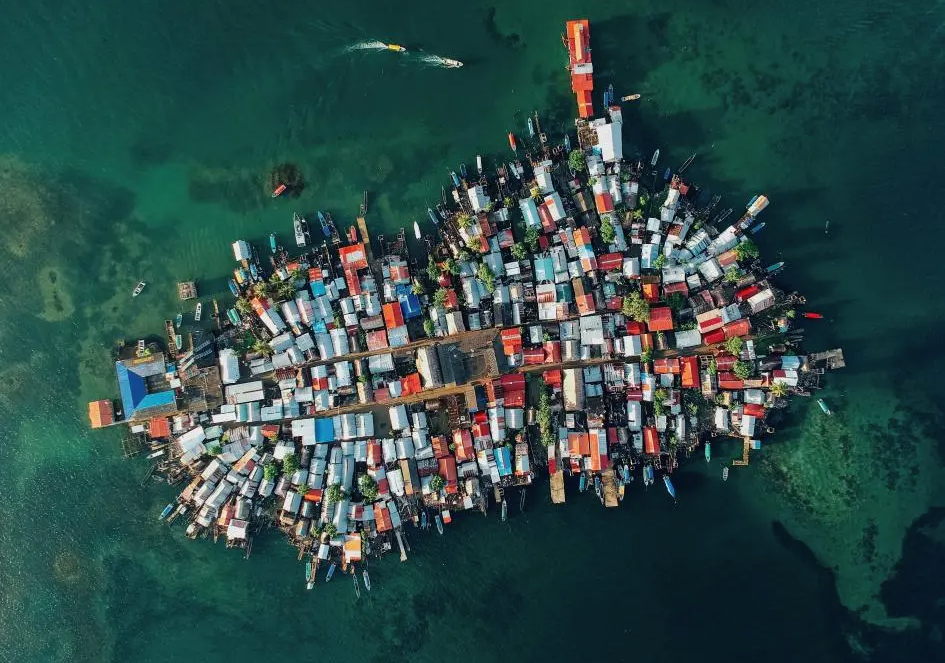Sea level rise not only threatens coastal infrastructure and traditional livelihoods but also sheds light on the deep gaps in housing and land-use planning policies in Latin America. According to the State of the Climate in Latin America and the Caribbean 2020 Report of the World Meteorological Organization (WMO), “in Latin America and the Caribbean more than 27% of the population lives in coastal areas, and it is estimated that between 6% and 8% live in areas that are at high or very high risk of being affected by coastal hazards.”
In Panama, a nation with 2,988 kilometers of coastline on both oceans, data published by the Ministry of Environment (MIAMBIENTE) and analyzed by the Urban Risk Observatory (ORU) of Florida State University and Esri Panama indicate that between 2% and 3% of the currently existing land area will be affected by sea level rise by 2050.
One of the regions that has begun to feel the impact of this phenomenon earliest is the indigenous region of Guna Yala, which emerges as a microcosm of the complex interactions between climate change and vulnerable communities. The impacts are more noticeable in this comarca due to its location in the Caribbean Sea, where, according to data from the World Meteorological Organization (WMO), sea level rise has been higher than the global average of 3.3 millimeters per year, with an average of 3.6 mm per year.
Gardí Sugdub: the first Panamanian climate migrants
The first community to take the initiative to move to the mainland in the Guna Yala region was Gardi Sugdub, a small island, 300 meters long by 125 meters wide, only one meter above sea level and with some 1,054 inhabitants. A 2023 Human Rights Watch report notes that “planning for the relocation began in 2010, when Gardi Sugdub leaders created the neighborhood committee to organize the process, secure and clear new land on the mainland donated by community members.”
This same Human Rights Watch report notes: “Planned relocation is often considered a measure of last resort, after all, on-site adaptation strategies — such as elevating houses or building dykes — have been tried and discarded as inadequate. Although flood damage and the anticipation of future climate change impacts are often the most visible factors.”
In general terms, the condition of the Guna Yala comarca is one of state neglect. It subsists under pressures related to overcrowding, precarious housing conditions, lack of access to basic services, lack of infrastructure, illegal migration, drug trafficking, sexually transmitted diseases, and migration to the city, in addition to the increase in extreme weather events and environmental deterioration.
For the Gunas, the needle marking the progress of social progress has barely moved during the 21st century. Between the 2000 census and 2023, the percentage of homes without potable water went from 31% to 24%, and that of homes without sanitation from 99% to 95%. Households with an income of less than US$600 per month went from 88% to 74%. Overcrowding is another serious problem in this region. The Gunas have recorded the highest average number of inhabitants per dwelling in the country, with 7 and 4 inhabitants in both the 2000 and 2023 censuses, respectively.
With these indicators as a backdrop, what has happened is that the Guna population has begun to migrate. In 2000, 50% of the indigenous Guna resided in the comarca, and today this percentage is only 27%. The destination of these migrants has been the Province of Panama — where the country’s capital is located — where 32% of the Guna population is concentrated.
Unfulfilled promises and the challenges of a not-so-distant future
The report published by Human Rights Watch also emphasizes the state of abandonment of the indigenous Guna: “The government’s track record is unconvincing: in 2011, MINSA promised a hospital; in 2012, MEDUCA promised a model school; and in 2017, MIVIOT promised 300 houses. All projects have been initiated, but none have been completed.” So far, the community move has not taken place, and the infrastructures are built and unusable.
Land, its access, planning, and management are some of the main challenges in this process of relocation of communities threatened by sea level rise. Displacement Solutions, an NGO that has repeatedly visited the Guna Yala comarca since 2014, states, “It will be land that will ultimately be at the center of most policies designed to address the consequences of climate displacement. People will lose land and will need new land to start their lives anew.”
In the face of the threat that climate change poses to communities, the Peninsula Principles emerged as an “international legal instrument on the rights of climate displaced persons.” These principles indicate that it is necessary, “prior to any relocation, that a relocation master plan be prepared that addresses critical issues such as: i) land acquisition; ii) preservation of existing social and cultural institutions; and iv) access to public services”, among other aspects. However, so far, Panama does not have the studies to implement these principles.
The threat of sea level rise is a challenge shared by at least 928 communities and 700,000 people in Panama. In the Guna Yala comarca, at least 40 communities and 32,000 people will be potentially affected. Displacement of communities will not be required in all cases, but investments and planning will be needed to address the protection of their assets and livelihoods.
2050 still seems a long way off. It was in 1983 when the first signs of sea level rise were identified in Panama, and it was still so in 1998 when they were confirmed. The year 2010 — when the inhabitants of Gardí Sugdub decided to move to the mainland — seems like a short time ago, and now, in 2023, we are halfway between the past and the future. However, the story captured in this article tells how, still, after 40 years of warnings, we are not prepared for the challenge posed by climate change.
*Translated by Janaína Ruviaro da Silva from the original in Spanish.













